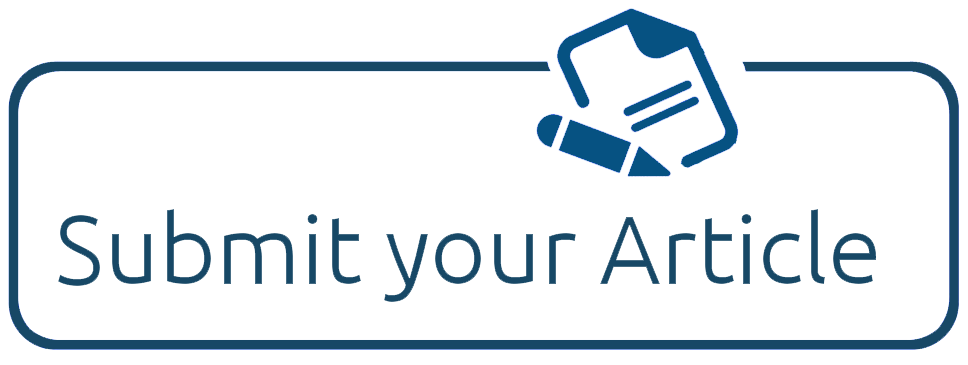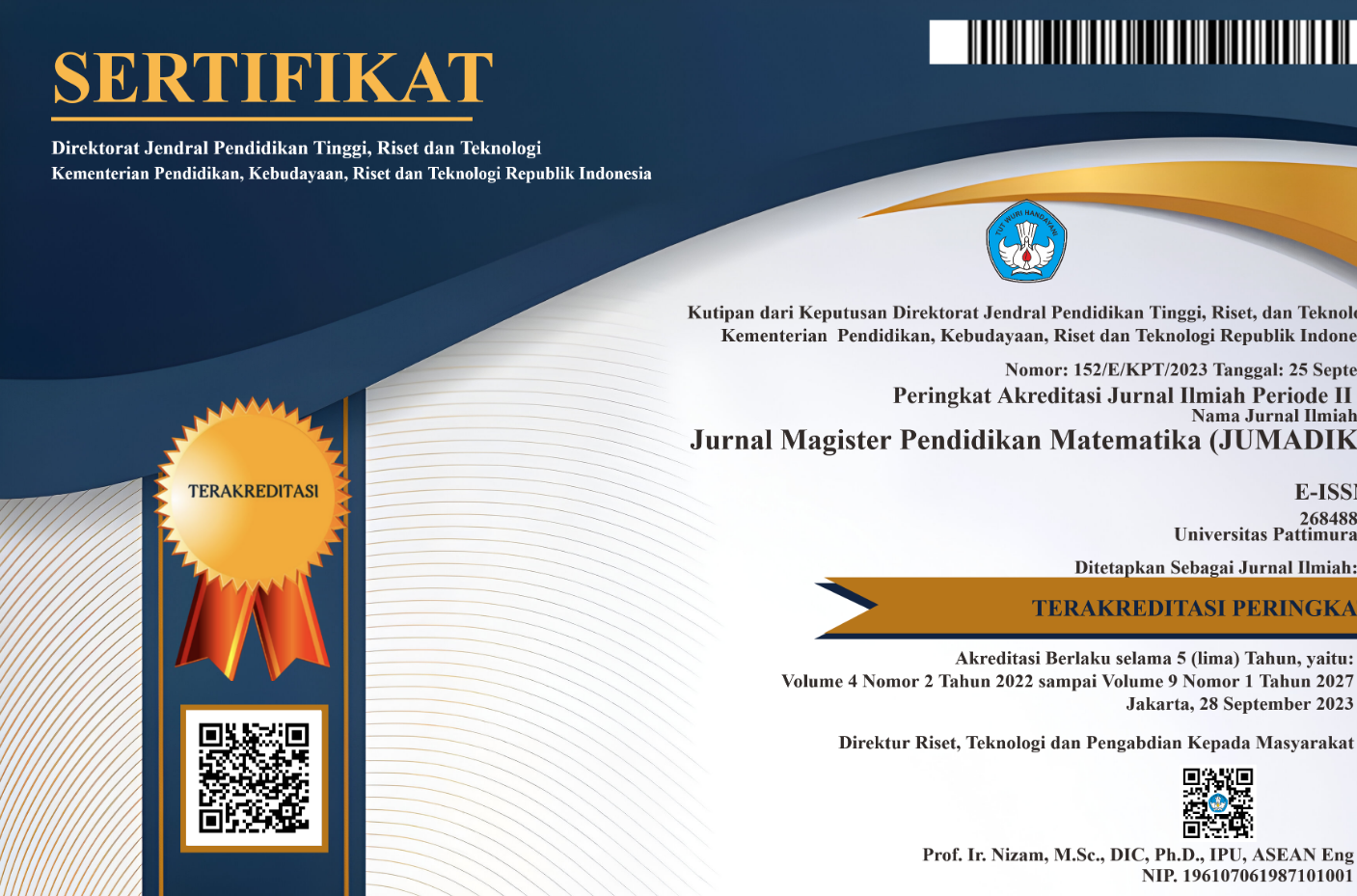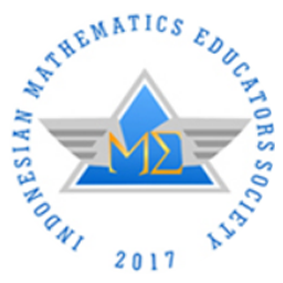PENGEMBANGAN MEDIA FLIPBOOK BERBASIS REALISTIC MATHEMATICS EDUCATION PADA KEMAMPUAN KOMUNIKASI MATEMATIS PESERTA DIDIK
Abstract
Teacher’s lack of interactive learning media and abstract mathematics learning materials results in low mathematical communication skills as indicated by students' answers in solving math problems. Flipbook media is one of the interactive and interesting learning media in learning mathematics which accommodates the principles of the Realistic Mathematics Education (RME) approach. This study aims to determine the procedure for developing RME-based flipbook media and to determine students' mathematical communication skills after using the media developed on circle material. This type of research is R & D (Research & Development) research using the 4D development model (Define-Design-Develop-Disseminate). The subjects in this study were 3 mathematics teachers, 6 students taken from each class VIII outside class VIII-E, 2 material experts, 2 media experts and 32 students from class VIII-E SMPN 3 Banjar. Data collection techniques are observation, interviews, questionnaires and tests. The data analysis technique used is descriptive statistical analysis and qualitative data analysis. Based on the analysis of the results of the mathematical communication ability test, as many as 31.25% of students showed a level of mathematical communication ability in the "high" category, as many as 43.75% of students showed a level of mathematical communication ability in the "medium" category as many as 25% of students shows the level of mathematical communication skills in the "low" category. It can be concluded that RME-based flipbook learning media is feasible and effective in students' mathematical communication skills. This research is a reference for teachers to make flipbooks using Flip PDF Professional software which can assist the learning process and further researchers can conduct research and development of flipbooks in collaboration with other software on different material and mathematical abilities
Downloads
References
Agustin, E.C., Kusumajanto, D., Dian Wahyudi, H., & Hidayat, R. (2021). Pengembangan E-Modul berbantuan Aplikasi Flip Builder pada Mata Pelajaran Marketing (studi pada kelas X bisnis daring dan pemasaran SMKN 1 Turen). Jurnal Ekonomi, Bisnis dan Pendidikan, 1(5), 470-478.
Arikunto, S., & Jabar, C. S. A. (2014). Evaluasi program pendidikan: pedoman teoritis praktisi pendidikan (2nd ed.). Bumi Aksara.
Fauzan, A., Musdi, E., & Yani, R. (2017). The influence of realistic mathematics education (RME) approach on students' mathematical representation ability. Advance in Social Science, Education and Humanities Research, 173, 9–12.
Friansah, D., Adha, I., & Refianti, R. (2018). Pengembangan Pocket Book Berbasis Pendekatan Matematika Realistik Indonesia (PMRI) Materi Bangun Ruang Sisi Datar. Jurnal Pendidikan Matematika (Judika Education), 1 (1), 1-10.
Hilaliyah, N., Sudiana, R., & Pamungkas, A. S. (2019). Pengembangan Modul Realistic Mathematics Education Bernilai Budaya Banten untuk Mengembangkan Kemampuan Literasi Matematis Siswa. Jurnal Didaktik Matematika, 6(2), 121–135.
Lady, A., Utomo, B. T., & Lovi, C. (2018). Improving mathematical ability and student learning outcomes through realistic mathematic education (RME) approach. International Journal of Engineering and Technology, 7(2), 55–57.
Laurens, T., Batlolona, F. A., Batlolona, J. R., Leasa, M. (2018). How does realistic mathematics education (RME) improve students’ mathematics cognitive achievement?. EURASIA Journal of Mathematics, Science and Technology Education, 14(2), 569-578.
NCTM. (2000). Principles And Standards For School Mathematics. USA: nctm.org
Ndiung, S., Sariyasa., Jehadus, E., & Apsari, R. A. (2021). The effect of treffinger creative learning model with the use RME principles on creative thinking skill and mathematics learning outcome. International Journal of Instruction, 14(2), 873-888.
Nuswantari, D., Amry, Z., & Siagian, P. (2020). Development of Learning Materials Through RME Assisted by Geogebra Software to Improve Students Problem Solving ability. Journal of Education and Practice, 11(8), 61–68.
Seruni, R., Munawaroh, S., Kurniadewi, F., & Nurjayadi, M. (2019). Pengembangan Modul Elektronik (E-Modul) Biokimia pada Materi Metabolisme Lipid menggunakan Flip Pdf Professional. Jurnal Tadris Kimiya, 4(1), 48-56.
Shoimin, A. (2014). Enam Puluh Delapan (68) Model Pembelajaran Inovatif dalam Kurikulum 2013. Yogyakarta: Ar-Ruzz Media.
Sugiyono. (2018). Penelitian Pengembangan (R&D). Bandung: Alfabeta.
Sundayana. (2014). Media dan Alat Peraga dalam Pembelajaran Matematika. Bandung: Alfabeta.
Sundayana, R., Herman, T., Dahlan, J. A., & Prahmana, R. C. I. (2017). Using ASSURE learning design to develop students’ mathematical communication ability. World Transactions on Engineering and Technology Education, 15(3), 245–249.
Tafonao, Talizaro. (2018). Peranan Media Pembelajaran Dalam Meningkatkan Minat Belajar Mahasiswa. Jurnal Komunikasi Pendidikan. 2(2), 103-114
Thiagarajan S., Semmel D., & Semmel M. I. (1974). Intructional Development For Training Teachers Of Exceptional Children: A Sourcebook. Minneapolis: Central for Innovation on Teaching the Handicaped.
Wibawanto, W.. (2017). Desain dan Pemrograman Multimedia Pembelajaran Interaktif. Jember: Cerdas Ulet Kreatif.
Wulandari, S., Darma, Y., & Susiaty, U. D. (2019). Pengembangan Modul Berbasis Pendekatan Realistic Mathematics Education (RME) Terhadap Pemahaman Konsep. Jurnal Pendidikan Informatika Dan Sains, 8(1), 143.
Copyright (c) 2023 Karsim Karsim, Nani Ratnaningsih, Diar Veni Rahayu

This work is licensed under a Creative Commons Attribution-NonCommercial-ShareAlike 4.0 International License.
License and Copyright Agreement
In submitting the manuscript to the journal, the authors certify that:
- They are authorized by their co-authors to enter into these arrangements.
- The work described has not been formally published before, except in the form of an abstract or as part of a published lecture, review, thesis, or overlay journal. Please also carefully read Jurnal Magister Pendidikan Matematika (JUMADIKA) Posting Your Article Policy.
- That it is not under consideration for publication elsewhere,
- That its publication has been approved by all the author(s) and by the responsible authorities – tacitly or explicitly – of the institutes where the work has been carried out.
- They secure the right to reproduce any material that has already been published or copyrighted elsewhere.
- They agree to the following license and copyright agreement.
Copyright
Authors who publish with Jurnal Magister Pendidikan Matematika (JUMADIKA) agree to the following terms:
- Authors retain copyright and grant the journal right of first publication with the work simultaneously licensed under a Creative Commons Attribution-NonCommercial-ShareAlike 4.0 International License (http://creativecommons.org/licenses/by-nc-sa/4.0/) that allows others to share the work with an acknowledgment of the work's authorship and initial publication in this journal.
- Authors are able to enter into separate, additional contractual arrangements for the non-exclusive distribution of the journal's published version of the work (e.g., post it to an institutional repository or publish it in a book), with an acknowledgment of its initial publication in this journal.
- Authors are permitted and encouraged to post their work online (e.g., in institutional repositories or on their website) prior to and during the submission process, as it can lead to productive exchanges, as well as earlier and greater citation of published work.








